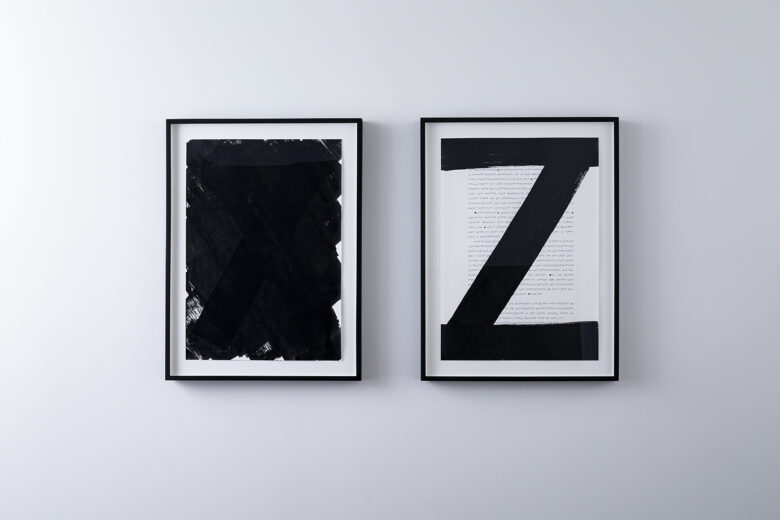ROOM 08 ライアン・ガンダー / RYAN GANDER

"Pre-everything; Stabs at academia with painters tools”

ライアン・ガンダーは、新世代コンセプチュアルアートの旗手として知られ、2011年に開催された第54回ヴェネチアビエンナーレや2012年のドクメンタ13などの大規模な芸術祭や世界各地での展覧会に多数参加するなど国際的に活躍するアーティストである。日本では2022年に東京オペラシティアートギャラリーで開催され大好評を博した個展「われらの時代のサイン」が記憶に新しい。また大阪府にある国立国際美術館や石川県の金沢21世紀美術館の収蔵作家でもあるので、これらの美術館の収蔵品展でガンダーの作品を目にする機会も少なくないと思われる。
ガンダーの作品は、既に存在している美術作品や日常生活で遭遇する物事などを素材として、オブジェ、インスタレーション、絵画、写真、映像、さらには出版やキュレーションへと及び、既成の型にはまらない、多様な表現形態をとっている。ガンダーに特徴的なのは、意外なものの結合、架空の状況の設定、情報の部分的な隠蔽、ユーモアの導入、過去と未来への誘導など、作品にまつわる思考を重要視していることであり、その手法はユニークかつ、示唆に富んでいる。そして、美術全般についての考察や、見ることについての洞察、日常経験の分析など、知的な思考が制作の背景となっている。その作品は、鑑賞者の想像力を活性化し、新たな思考回路を生み出すとともに、物事の認識を拡張する、「世界を読み解くための装置」とも言えるものである。
《Pre-everything; Stabs at academia with painters tools》は、ガンダーの制作活動において重要な要素の一つである、「変換」をテーマにしたドローイングである。「Stabs at academia with painters tools」は、イタリアの国民的小説家、イタロ・カルヴィーノの小説「冬の夜ひとりの旅人が」のヴィンテージクラシック版をもとに、ガンダーによる独自のフォント「Set in Stone」を用いて再構成した本であり、この本からさらに、ドローイング作品が生み出された。「Set in Stone」は、ガンダーの子供が拾い集めた石の形に着想を得て作られたフォントであり、ガンダーは、様々なかたちの石の羅列を5万年前のノイズであり、母音の基礎を構成する、言語の始まりであると考えている。各ページに筆で描かれた墨汁の黒い線は、ガンダーによる小説への注釈を表す記号である。カルヴィーノは文学の魔術師と評され、メタフィクションの手法を用いた「冬の夜ひとりの旅人が」では、読み始めても同じ文章が繰り返され、小説の続きを追っていくと背後に偽作本を作り続ける翻訳者の存在が浮上する。ガンダーはこの「読もうとしても読めない」もどかしさや、「偽作本を作り続ける者の存在」などを引き継ぎながらも、小説を独自の手法で自らの作品へと変換していく。そうした変換作業の繰り返しを経て、もとの形からは大きく変容した姿となったドローイングには、変容を受け入れることで生まれる新たな創造の可能性が示されている。
Ryan Gander is known as one of the leading artists of new generation conceptual art and an internationally active artist who has participated in numerous exhibitions worldwide, including large art festivals such as the 54th Venice Biennale in 2011 and Documenta13 in 2012. His solo exhibition ‘The Markers of Our Time’ at the Tokyo Opera City Art Gallery in 2022 received great acclaim and is still fresh in the audience’s memory. His works are also part of a permanent collection of the National Museum of Art, Osaka, and the 21st Century Museum of Art, Kanazawa, Ishikawa, which offers the art lovers copious opportunities to see Gander’s works at collection exhibitions at these museums in Japan.
Gander uses artworks that already exist and events encountered in daily life as his material, which take various forms of expression that are ‘out of the box’ including objects, installations, painting, photography, and videography, extending to publishing and curation. Gander is distinctive because he prioritizes thought put into the artwork and his methods are unique and insightful; surprising combinations, fictional settings, concealment of partial information, introducing humor, and guidance to the past and future. The background of his work lies in his intellectual thoughts around observations of art in general, insights on the act of seeing, and analysis of daily experience. His works can be described as an “apparatus of understanding the world” by stimulating the audience’s imagination, creating a new train of thought, and expanding the perception of events.
Gander views the arrangement of variously shaped stones as noise from 50 thousand years ago—the beginning of language, making up the foundation of vowels. The black lines drawn with brush and ink on each page are signs by Gander indicating annotations to the novel. Calvino was hailed as a magician of letters, and in If on a winter’s night a traveler, he deploys metafictional methods: the same opening lines appear repeatedly, and as the reader progresses through the book the presence of a translator emerges, creating a counterfeit work in the background.
Gander preserves elements such as the frustration of trying to read but failing and the presence of a figure who continuously creates a counterfeit, but transforms the novel into a work of his own through these unique methods. Through repetition of this work of transformation, the drawing’s shape is greatly changed from its original state, indicating the possibility for new creations to be born when such modifications are accepted.

